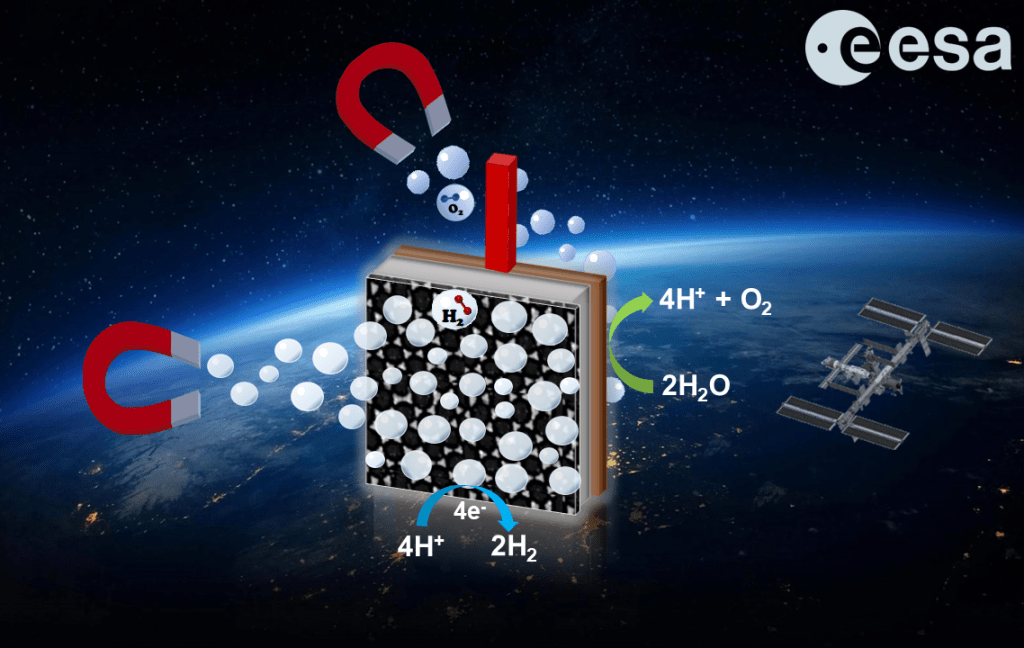
Photoelectrochemical devices integrate the processes of light absorption, charge separation, and
catalysis for chemical synthesis. The monolithic design and sustainable operation are interesting for space applications, where weight and volume constraints predominate. However, hindered gas bubble desorption in reduced gravity limits the application in space.
Prof. Katharina Brinkert’s group at the University of Warwick and the LGST Lab were recently awarded an ESA SciSpace grant to provide a proof-of-concept microgravity test of an autonomously operating, efficient, and monolithic solar water-splitting device for oxygen and hydrogen production which could complement currently existing life support technologies. In order to achieve efficient and stable gas production, we will investigate two key mechanisms to successfully detach hydrogen and oxygen gas bubbles from the electrode surface and direct them through the electrolyte solution to a gas collection point: (i) magnetically-induced buoyancy, and (ii) hydrophilic electrocatalyst structures. The longer microgravity time provided by the sounding rocket experiment will be crucial to successfully demonstrate the effect of both mechanisms.
Our results will not only be key for demonstrating the possibility of utilizing photoelectrochemical devices in space which could be extended e.g., to carbon dioxide removal and chemical synthesis – they will also be instrumental in optimizing electrolyzer systems, phase separators, and boiling processes in reduced gravitation.
Journal Articles:
- Ömer Akay, Macià Monfort-Castillo, Shaumica Saravanabavan, Álvaro Romero-Calvo*, Katharina Brinkert*, “Magnetic gas bubble management for enhanced water splitting in microgravity”, under review
- Á. Romero-Calvo, A. Ömer, H. Schaub, and K. Brinkert. “Magnetic phase separation in microgravity“, npj Microgravity, Vol. 8, No. 32, 2022, doi: 10.1038/s41526-022-00212-9
Conference Papers & Presentations:
- Ö. Akay, K. Brinkert, Á. Romero-Calvo, “Optimizing (Photo-)Electrolysis in Microgravity with Magnetohydrodynamic Forces: A Statistical Analysis Approach for Enhanced Efficiency”, 2024 COSPAR Scientific Assembly, Busan, South Korea, July 13-21, 2024.
- K. Brinkert, Ö. Akay, Á. Romero-Calvo, K. Walayat, J. Becker, “Realizing Efficient (Photo-)Electrochemical Water-Splitting in Space: An Experimental Set-Up for a Suborbital Rocket Flight”, 2024 COSPAR Scientific Assembly, Busan, South Korea, July 13-21, 2024.
- Á. Romero-Calvo, K. Brinkert, “Leveraging Magnetohydrodynamic Mechanisms for Stable and Efficient Microgravity Electrolysis”, ECS Meeting 2023, Boston, MA, May 28-June 2, 2023
- K. Brinkert, Á. Romero-Calvo, “Releasing the Bubbles: Efficient Phase Separation in (Photo-)Electrochemical Devices in Microgravity Environment”, ECS Meeting 2023, Boston, MA, May 28-June 2, 2023
- S. Saravanabavan, O. Akay, Á. Romero-Calvo*, K. Brinkert*, “Efficient and Stable Hydrogen and Oxygen Production in Microgravity”, ASGSR Meeting 2022, Houston, TX, November 9-12, 2022
- K. Brinkert, Á. Romero-Calvo, O. Akay, “Efficient and Stable Hydrogen and Oxygen Production in Microgravity”, 27th ELGRA Biennial Symposium & General Assembly, Lisbon, Portugal, September 6-9, 2022
- K. Brinkert, O. Akay, S. Saravanabavan, E. Sokalu, Á. Romero-Calvo, “Recent Advances in (Photo-)electrochemical Hydrogen and Oxygen Production for Space Exploration”, 44th COSPAR Scientific Assembly, Athens, Greece, July 16-24, 2022
- K. Brinkert, O. Akay, S. Saravanabavan, E. Sokalu, Á. Romero-Calvo, “Photoelectrochemical Hydrogen and Oxygen Production in Microgravity Environment”, 44th COSPAR Scientific Assembly, Athens, Greece, July 16-24, 2022
- Á. Romero-Calvo, O. Akay, K. Brinkert, “Diamagnetic phase separation in microgravity”, 44th COSPAR Scientific Assembly, Athens, Greece, July 16-24, 2022
Patents:
- Á. Romero-Calvo, H. Schaub, “Systems and Methods for Magnetic Buoyancy Enhanced Electrolysis and Boiling Systems”, US 2023/0265573 A1, August 2023

